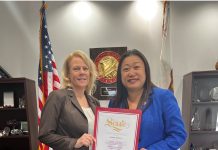Before the year’s end, motorists near Laguna Beach High School may get the chance to roll through the town’s first traffic-easing roundabout thanks to a City Council vote Tuesday.
Combined with another decision to award a contract for development of a mobility plan for Laguna Beach, the council took steps forward in complying with the state’s “complete streets” mandate to make streets accessible to cyclists and pedestrians as well as vehicles.
The council first approved the concept of a trial roundabout in January, one of several modifications suggested by Riverside transportation consultant Fehr & Peers. Then, the council also approved more visible pedestrian crosswalk markings on Glenneyre Street as well as shared-lane street markings, known as sharrows, and bike route signage on Cliff Drive and Glenneyre to discourage cyclists from Coast Highway.
After awarding a contract in April, the council reviewed the completed designs this week.
Fehr & Peers conceived the trial roundabout for the intersection of Glenneyre and Cress Streets. Even so, council members Toni Iseman and Bob Whalen opposed the location because it would require reducing traffic lanes on Glenneyre for a block on either side of the roundabout. Instead, they proposed and approved the traffic-smoothing device for Catalina Street and Los Robles, a confusing intersection for motorists where residential streets merge from five directions.
Resident Theresa Cordova commented that small changes can help sway public opinion in favor of larger changes and lauded the trial roundabout as a “toe in the water” in Laguna’s exploration of more significant complete streets options.
Such options might soon be on the table. The Council also approved a $200,000 contract with Irvine’s RBF Consulting to prepare an enhanced mobility and complete streets plan.
RBF was one of five firms competing for the task, funded because staff sought and won a $180,000 Caltrans transportation planning grant. The grant requires that the city match 10 percent of the award.
Principal planner Scott Drapkin explained that Caltrans stipulates that preparation of the plan include a significant public outreach effort along with meetings with relevant city commissions. He also outlined concurrent efforts underway to improve the city’s often clogged circulation, such as an analysis of mobility on Laguna Canyon Road, a review of the city’s bus and trolley service and implementation of a parking management plan. Drapkin said that staff plans to hold combined outreach meetings when these studies have overlapping subject matter and will ask the individual firms to work together on similar issues, share data and schedule a joint community workshop in October.
“I’m excited to see this go forward,” said Chris Prelitz, chair of Laguna’s complete streets task force, praising Drapkin and Director of Community Development John Montgomery for their effort to pursue the grant.
Resident Billy Fried called the news of the plan “awesome, fantastic, amazing,” and thanked staff for finding the grant money. “This is really thinking about tomorrow,” he added.





Like the parking garage, roundabouts are expensive and do little or nothing to balance a mobility plan serving pedestrians, cyclists, transit users and private automobiles safely – the state mandate of Complete Streets. Also like the parking garage they serve automobiles exclusively, particularly in Laguna where space for roundabouts is severely limited and the infrastructure for other mobility modes does not exist. Since Laguna has no mobility plan and little measured traffic data, it is unclear how building roundabouts willy-nilly would serve our mobility. Prelitz and Fried are once again running-about at city hall, will Transition Laguna please come and get them.
Although a long time coming, Laguna’s trial roundabout is a great first step toward better and safer infrastructure for all users of the roadway. Roundabouts are endorsed by CalTrans because they provide “safety improvements, intersection capacity improvement, and an overall betterment in operational characteristics of the intersection.” Moreover, the Federal Highway Administration promotes the use of roundabouts as one of its “proven safety countermeasures.”
The proof is in the data. According to the FHWA, ” . . . by converting from a two-way stop control mechanism to a roundabout, a location can experience an 82 percent reduction in severe (injury/fatal) crashes and a 44 percent reduction in overall crashes. By converting from a signalized intersection to a roundabout, a location can experience a 78 percent reduction in severe (injury/fatal) crashes and a 48 percent reduction in overall crashes.”
The improved safety provided by roundabouts is critical to enabling more Laguna residents and visitors, alike, to walk and bicycle around town rather than choosing a car. That, in turn, will reduce demand on scarce parking spots and consequently improve the commercial environment b/c more people will be able to patronize local restaurants and businesses car-free.
Keep moving forward, Laguna Beach, one roundabout at a time!
(for more info, see: http://safety.fhwa.dot.gov/provencountermeasures/fhwa_sa_12_005.htm and
http://www.dot.ca.gov/hq/oppd/dib/dib80-01.htm)
The city engineer cites a preliminary plan on-file for the Las Rhobles and Catalina roundabout as proposed in 2002 by consultants Otterson and Associates. Their report reads “Pedestrian access to the central island should be prohibited” and “Bicyclists have a difficult time with roundabouts”. So the design proposed supports car traffic and not other modes, the point of my first remark. The report summary says “construction of a roundabout at this location would serve no real traffic circulation improvement, as there is no significant accident history at this location to warrant a change in traffic control…… but would provide a significant improvement in neighbourhood aesthetics”. A simple aesthetic $1,000 bike-rack at the Post Office would do more to encourage balanced mobility than this $125,000 roundabout.